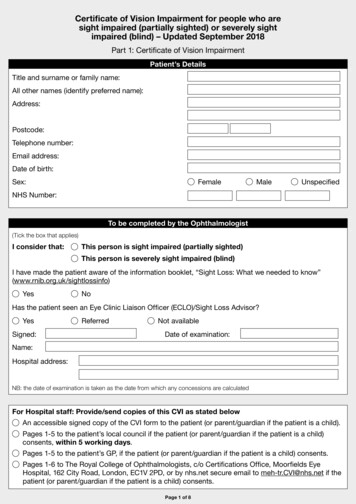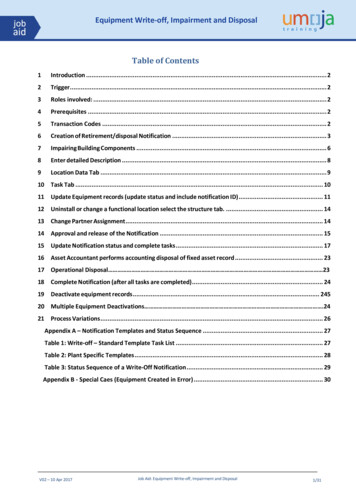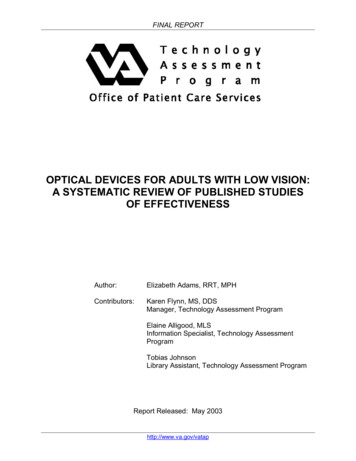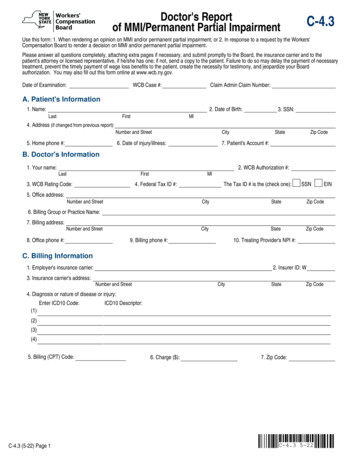
Transcription
Certificate of Vision Impairment for people who aresight impaired (partially sighted) or severely sightimpaired (blind) – Updated September 2018Part 1: Certificate of Vision ImpairmentPatient’s DetailsTitle and surname or family name:All other names (identify preferred name):Address:Postcode:Telephone number:Email address:Date of birth:Sex:FemaleMaleUnspecifiedNHS Number:To be completed by the Ophthalmologist(Tick the box that applies)I consider that:This person is sight impaired (partially sighted)This person is severely sight impaired (blind)I have made the patient aware of the information booklet, “Sight Loss: What we needed to know”(www.rnib.org.uk/sightlossinfo)YesNoHas the patient seen an Eye Clinic Liaison Officer (ECLO)/Sight Loss Advisor?YesSigned:ReferredNot availableDate of examination:Name:Hospital address:NB: the date of examination is taken as the date from which any concessions are calculatedFor Hospital staff: Provide/send copies of this CVI as stated belowAn accessible signed copy of the CVI form to the patient (or parent/guardian if the patient is a child).Pages 1-5 to the patient’s local council if the patient (or parent/guardian if the patient is a child)consents, within 5 working days.Pages 1-5 to the patient’s GP, if the patient (or parent/guardian if the patient is a child) consents.Pages 1-6 to The Royal College of Ophthalmologists, c/o Certifications Office, Moorfields EyeHospital, 162 City Road, London, EC1V 2PD, or by nhs.net secure email to meh-tr.CVI@nhs.net if thepatient (or parent/guardian if the patient is a child) consents.Page 1 of 8
Part 2: To be completed by the OphthalmologistVisual functionBest corrected visual acuity:Right eyeLogmar SelectSnellen SelectLeft eyeLogmarSnellenSelectSelectBinocular (Habitual)Logmar SelectSnellen SelectField of visionExtensive loss of peripheral visual field (including hemianopia)YesLow vision serviceIf appropriate, has a referral for thelow vision service been made?Don’t knowYesNoNoNot RequiredPart 2a: Diagnosis (for patients 18 years of age or over)Tick each box that applies. Tick the main cause button if this isthe main reason for the impairment.RetinaMaincauseICD 10 codeage-related macular degeneration – choroidalneovascularisation (wet)H35.32age-related macular degeneration – atrophic/geographic macular atrophy (dry)H35.31age-related macular degeneration unspecified(mixed)H35.30diabetic retinopathyE10.3-E14.3 H36.0diabetic maculopathyH36.0Ahereditary retinal dystrophyH35.5retinal vascular occlusionsH34other retinal (specify)H35primary open angleH40.1primary angle closureH40.2secondaryH40.5other glaucoma (specify)H40Globedegenerative myopiaH44.2Neurologicaloptic atrophyH47.2visual cortex disorderH47.6cerebrovascular diseaseI60-I69chorioretinitisH30.9choroidal degenerationH31.1Lenscataract (excludes congenital)H25.9Corneacorneal scars and opacitiesH17keratitisH16eyeC69brain & CNSC70-C72, D43-D44other neoplasia (specify)C00-C68, C73-C97,D00-D42, nosis not covered in any of the above, specify, including ICD 10 code if known and indicating eye or eyes*Please note that this is not intended to be a comprehensive list of all possible diagnoses.Page 2 of 8
Part 2b: Diagnosis (for patients under the age of 18)Tick each box that applies. Tick the main cause button if this isthe main reason for the impairment.Central Visual cerebral/cortical pathology affecting mainlyPathwaya) acuity b) fields c) visual perception (circle)ProblemsnystagmusWhole Globeand tic NerveMaincauseICD 10codeRighteyeLefteyeH47.6H55other anised globe/phthisisH44anterior segment anomalyQ13primary congenital/infantile glaucomaQ15, H40.1-H40.2other glaucomaH40.8-H40.9stimulus ityH17dystrophyH18.4other 6.9secondaryH26.4aniridiaQ13.1colobomaQ12.2, Q13.0uveitisH20other (specify)H21retinopathy of prematurityH35.1retinal dystrophyH35.5retinitisH30other tinal detachmentH33other (specify)H35hypoplasiaQ11.2other congenital anomalyQ14.2optic atrophyH47.2neuropathyH47.0other (specify)H47.0Diagnosis not covered in any of the above, specify, including ICD 10 code if known and indicating eye or eyesPage 3 of 8
Part 3: To be completed by the patient (or parent/guardian if the patient is a child)and eye clinic staff e.g. ECLO/Sight Loss AdvisorAdditional information for the patient’s local councilIf you are an adult do you live alone?YesNoDoes someone support you with your care?YesNoDo you have difficulties with your physical mobility?YesNoDo you have difficulties with your hearing?YesNoDo you have a learning disability?YesNoDo you have a diagnosis of dementia?YesNoAre you employed?YesNoAre you in full-time education?YesNoIf the patient is a baby, child or young person, is your child/are you known to the specialist visualimpairment education service?YesNoDon’t knowRecord any further relevant information below e.g. medical conditions, emotional impact of sight loss,risk of falls, benefits of vision rehabilitation and/or if you think the patient requires urgent support andreasons why.Patient’s information and communication needsAll providers of NHS and local authority social care services are legally required to identify, record andmeet your individual information/communication needs (refer to Explanatory Notes paragraphs 9, 22and 23).Preferred method of contact?telephoneemailletterPreferred method of communication e.g. BSL, deafblind manual?Large print 18Large print 22Large print 26Easy-ReadAudio CDEmailOther (specify)I don’t know and need an assessmentPreferred language (and identify if an interpreter is required)Page 4 of 8
Part 4: Consent to share informationI understand that by signing this formI give my permission for a copy to be sent to my GP to make them aware of this certificate.My GP name/practice:Address:Postcode:Telephone number:I give my permission for a copy to be sent to my local council (or an organisation working on theirbehalf) who have a duty (under the Care Act 2014) to contact me to offer advice on living with sight lossand explain the benefits of being registered. When the council contacts me, I am aware that I do nothave to accept any help, or be registered at that time, if I choose not to do so.My local council name:Address:Postcode:Telephone number:I give my permission for a copy to be sent to The Royal College of Ophthalmologists, CertificationsOffice at Moorfields Eye Hospital; where information about eye conditions is collected, and used to helpto improve eye care and services in the future.I understand that I do not have to consent to sharing my information with my GP, local council or TheRoyal College of Ophthalmologists Certifications Office, or that I can withdraw my consent at any pointby contacting them directly.I confirm that my attention has been drawn to the paragraph entitled ‘Driving’ on page 8 and understandthat I must not drive.Signed by the patient (or signature and name of parent/guardian or representative)Page 5 of 8
Ethnicity(this information is needed for service and epidemiological monitoring)White1. English/Northern Irish/Scottish/Welsh/British2. Irish3. Any other White background, describe belowMixed/Multiple ethnic groups4. White and Black Caribbean5. White and Black African6. White and Asian7. Any other Mixed/Multiple ethnic background, describe belowAsian/Asian British8. Indian9. Pakistani10. Bangladeshi11. Any other Asian background, describe belowBlack/African/Caribbean/Black British12. African13. Caribbean14. Any other Black/African/Caribbean background, describe belowChinese/Chinese British15. Chinese16. Any other Chinese background, describe belowOther ethnic group17. Other, describe belowPage 6 of 8
Information Sheet for patients (or parents/guardians if the patient is a child)CertificationKeep your Certificate of Vision Impairment (CVI). It has three main functions:1. It qualifies you to be registered with your local council as sight impaired (partially sighted) orseverely sight impaired (blind).2. It lets your local council know about your sight loss. They should contact you within twoweeks to offer registration, and to identify any help you might need with day-to-day tasks.3. The CVI records important information about the causes of sight loss. It helps in planningNHS eye care services and research about eye conditions.Registration and vision rehabilitiation/habilitationCouncils have a duty to keep a register of people with sight loss. They will contact you to talkabout the benefits of being registered. This is likely to be through the Social Services LocalSensory Team (or an organisation working on their behalf). Registration is often a positive stepto help you to be as independent as possible. You can choose whether or not to be registered.Once registered, your local council should offer you a card confirming registration. If you areregistered, you may find it easier to prove the degree of your sight loss and your eligibility forcertain concessions. The Council should also talk to you about vision rehabilitation if you are anadult, and habilitation if you are a child or young person and any other support that might help.Vision rehabilitation/habilitation is support or training to help you to maximise yourindependence, such as moving around your home and getting out and about safely.Early Years Development, Children andYoung People and EducationChildren (including babies) and young people who are vision impaired will require specialistsupport for their development and may receive special educational needs provision. Aneducation, health and care (EHC) plan may be provided. You do not need to be certified orregistered to receive this support or an EHC plan. This support is provided by the council’sspecialist education vision impairment service. Additional support from a social careassessment may also be offered as a result of registration. Information about the support yourcouncil offers to children and young people can be found on the ‘Local Offer’ page of theirwebsite. If you or your child are not known to this service talk to the Ophthalmologist orECLO/Sight Loss Advisor.Page 7 of 8
DrivingAs a person certified as sight impaired or severely sight impaired you must not drive and youmust inform the DVLA at the earliest opportunity. For more information, please contact:Drivers Medical Branch, DVLA, Swansea, SA99 1TU. Telephone 0300 790 6806.Email eftd@dvla.gsi.gov.ukWhere to get further information, advice and support“Sight Loss: What we needed to know”, written by people with sight loss, contains lots of usefulinformation including a list of other charities who may be able to help you.Visit www.rnib.org.uk/sightlossinfo‘Sightline’ is an online directory of people, services and organisations that help people withsight loss in your area. Visit www.sightlinedirectory.org.uk‘Starting Point’ signposts families to resources and professionals that can help with the firststeps following your child’s diagnosis. Visit www.vision2020uk.org.uk/startingpointYour local sight loss charity has lots of information, advice and practical solutions that can helpyou. Visit www.visionary.org.ukRNIB offers practical and emotional support for everyone affected by sight loss. Call theHelpline on 0303 123 9999 or visit www.rnib.org.ukGuide Dogs provides a range of support services to people of all ages. Call 0800 953 0113(adults) or 0800 781 1444 (parents/guardians of children/young people) or visit www.guidedogs.org.ukBlind Veterans UK provides services and support to vision impaired veterans. Call 0800 3897979 or visit www.noonealone.org.ukSeeAbility is a charity that acts to make eye care more accessible for people with learningdisabilities and autism. Their easy read information can be found at www.seeability.org/lookingafter-your-eyes or you can call 01372 755000.Page 8 of 8
geographic macular atrophy (dry) H35.31 age-related macular degeneration unspecified (mixed) H35.30: diabetic retinopathy E10.3-E14.3 H36.0: . Diagnosis not covered in any of the above, specify, including ICD 10 code if known and indicating eye or eyes: Page 4 of 8. Part 3: To be completed by the patient (or parent/guardian if the patient is .











